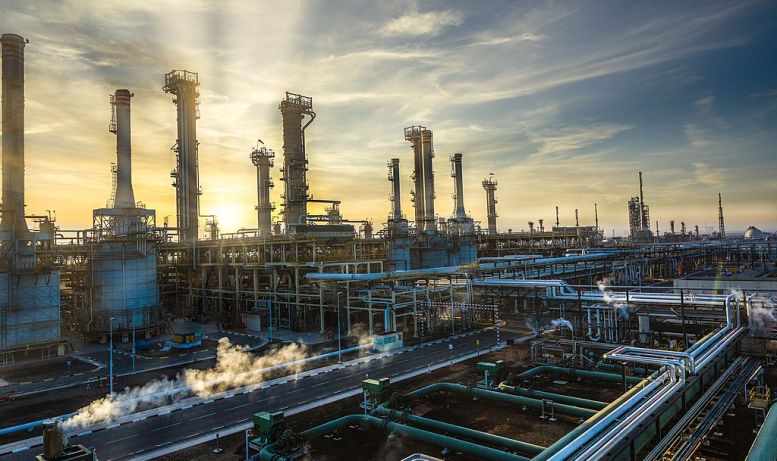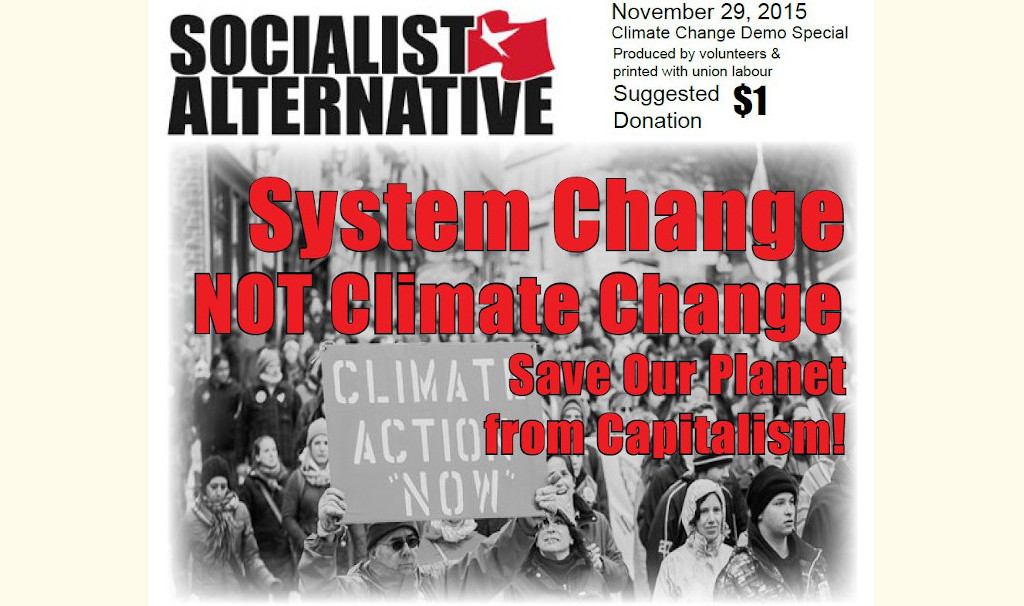Arne Johansson is a member of Socialistiskt Alternativ (ISA in Sweden).
“I cannot emphasise enough that time is running out. Irreversible climate tipping points are alarmingly close. We can either save our world or condemn humanity to a hellish future”, UN Secretary-General Antonio Guterres has summarised the scientific message ahead of the 28th UN Climate Change Conference, COP28, in the United Arab Emirates capital Dubai.
Unfortunately, there is nothing to suggest that COP28 will manifest anything other than another failure of the UN climate negotiations.
The massive failure to get to grips with the global climate crisis is the message of the latest report from the United Nations Framework Convention on Climate Change. The report holds out virtually no possibility of limiting warming to 1.5°C. or of averting the accelerating climate disasters that this implies.
In order to limit warming to the Paris Agreement’s target of no more than 2°C, the world needs to cut emissions by 28 percent by 2030. To stay within the safe limit of 1.5°C requires a 42 percent reduction at the same time. Yet greenhouse gases releases are still increasing!
Heading to 1.5°C Before 2027
Climate scientists warned earlier this year that there is a 66 percent probability that the world could reach 1.5°C for the first time before 2027. This has been underlined by the fact that by the beginning of October this year, with the added boost of the increased strength of the El Niño weather phenomenon, 86 consecutive days were recorded with temperatures exceeding pre-industrial levels by 1.5°C. September was the warmest month on record, with global average temperatures 1.8°C above pre-industrial levels.
But El Niño is only an amplifying factor. After a temporary dip during the COVID-19 pandemic, greenhouse gas emissions increased again between 2021 and 2022, meaning that, according to the UN’s Emissions Gap Report 2023 published in November, the world is heading for 3°C of warming by the end of this century. Today’s nationally pledged targets point to a 66 per cent probability of 2.9°C.
At COP28, a Global Stocktake will be done for the first time, showing how the world has so far succeeded or failed in delivering a roadmap in line with the Paris Agreement to limit warming to as close to 1.5°C as possible. According to the State of Climate Action 2023 report, the actions taken by the world’s countries so far are “woefully inadequate” in 41 of the 42 indicators used, ranging from power generation, buildings, industries and transport to forests and land, food and agriculture — as well as measures to capture carbon and finance climate change mitigation and adaptation.
The pace of action in more than half of the indicators needs to more than double this decade. Incredibly, six key indicators point in the wrong direction. While the share of electric vehicles sold in four years increased from 1.6 percent to 10 percent is considered a bright spot (the only one), global public subsidies for fossil fuels doubled between 2020 and 2021 to the highest level in a decade. At the same time, deforestation continued at a rate equivalent to the area of Croatia in 2022.
According to the same report, achieving the necessary interim targets by 2030 would require a dramatic increase in the rate of expansion of solar and wind power from 14 percent to 24 percent per year. Coal would need to be phased out seven times faster than today, light rail built six times faster — the equivalent of three times New York’s entire public transport system every year for the entire decade.
Sabotage of Climate Goals No mention is made of the rapidly growing sabotage of climate goals through war and the military arms race. According to the Global Landscape of Climate Finance 2023, the world’s grossly inadequate annual climate finance costs (flows) totalled US$1.3 trillion in 2021-2022, compared to roughly twice that amount in military spending. According to the Stockholm International Peace Research Institute’s estimate, the world’s military expenditure amounts to more than US$2.2 trillion, a figure that grossly underestimates the total military expenditure of the United States in particular.
As governments and companies increasingly turn a blind eye to the need to reduce emissions, they are talking more and more about offsetting continued emissions with measures to capture and store carbon dioxide from the atmosphere in forests and soil, bedrock and seabeds, and reach net zero through such “negative emissions” (Carbon Capture and Storage, CCS).
So far, this mostly involves biological methods using afforestation and biomass. The absurdity and frivolity of the world’s governments’ approach to climate change is demonstrated by the latest Land Gap Report, which states that the climate plans of rich and emission-leading countries include totally unrealistic proposal measures on a staggering scale. They suggest that one billion hectares of land will be restored or reforested — somewhere. This is an area larger than India, South Africa, Turkey and the EU combined!
The United Arab Emirates (UAE), the host country of the COP28 climate summit, is also a villain in this context, having burned in flares methane gas every day for 20 years. Under the leadership of Sultan Al Jaber, who is not only the president of the COP28 meeting but also the CEO of the state oil company ADNOC, the oil state is planning to compensate for continued large-scale oil and gas development with plantations in Africa. The UAE plans to plant or preserve forest on an area equal to half of Sweden covering 10 percent of Liberia and similar areas in Tanzania, Zambia, Zimbabwe and Kenya.
These projects very rarely generate any real emission reductions. For example, according to a recent study published in Science, millions of carbon credits approved by Verra, the world’s leading certifier in the industry, are virtually worthless. As forests dry, they are increasingly becoming carbon sources, and forest fires make this much worse. Canada’s fires this summer released over 410 million metric tons of carbon dioxide, more than the UK’s annual total.
These plans for ultra-large plantations also clash with the demands of food security, sustainable ecosystems and the rights of local populations in a world whose population is expected to grow by 1.7 billion by 2050, much of it in the major cities of Asia and Africa.
Emissions Capture and Storage: Reality Gap
Equally large is the gap between talk and reality when it comes to technical capture and storage of emissions. According to a research report from the University of Oxford, trends indicate that this would need to be increased 30 times by 2030 and 1,300 times more than so far by 2050. The International Energy Agency recently warned against banking on the technology, stating that oil and gas companies need to start “letting go of the illusion” that “implausibly large” amounts of carbon capture will solve the climate crisis.
“Companies can’t make a profit from permanently storing carbon dioxide underground, and so far, governments haven’t exactly jumped up and down with joy about pumping money into climate action,” one of the researchers behind the report told the Swedish newspaper Dagens Nyheter.
According to a long series of scientific studies, to meet climate targets most of the known reserves would have to stay in the ground. But according to data from the Global Oil and Gas Exit List (Gogel), which details the activities of more than 1,600 companies with 95 percent of global production, they are ignoring the warnings of the world’s climate scientists. According to statistics based on the International Energy Agency (IEA), no new oil and gas production can take place after 2023 if the 1.5C target is to be met. Yet the head of ADNOC, which runs one of the world’s three largest net-zero energy companies, alongside Saudi Aramco and QatarEnergy, will chair COP28 in Dubai.
According to the Gogel report, $170 billion has been invested in the search for new oil and gas reserves since 2021. Almost all (96 percent) of the 700 companies involved have continued on this path, while more than a thousand companies are planning new gas pipelines, gas-fired power plants and liquefied natural gas (LNG) export terminals.
“To keep 1.5C alive, a rapid, managed decline in oil and gas production is crucial. Instead, oil and gas companies are building a bridge to climate chaos, explains the head of the research team, Nils Bartsch, who also says he finds it hard to understand how an oil company boss like Al Jaber could have qualified to lead the climate negotiations.
“COP28 host UAE has world’s biggest climate-destroying oil plans,” summarises a telling headline in the UK’s The Guardian.
But against this absurd derailment of the UN climate negotiations, not a single one of the world’s capitalist governments, banks or corporations has raised so much as a peep of objection. For what would happen to the world’s financial markets if suddenly trillions of dollars invested in the bulk of the capitalist world’s energy system were suddenly found to be worthless?
Oxfam’s report for the COP28 Climate Equality, A Planet for the 99 percent, explained that the richest one percent account for as much of the pollution that heats up the planet as two-thirds of humanity.
Capitalism is taking humanity to disaster with a tiny minority doing most of the damage. Every day it is clearer that revolutionary, democratic and socialist change is needed to have the possibility of a decent life for future generations.




